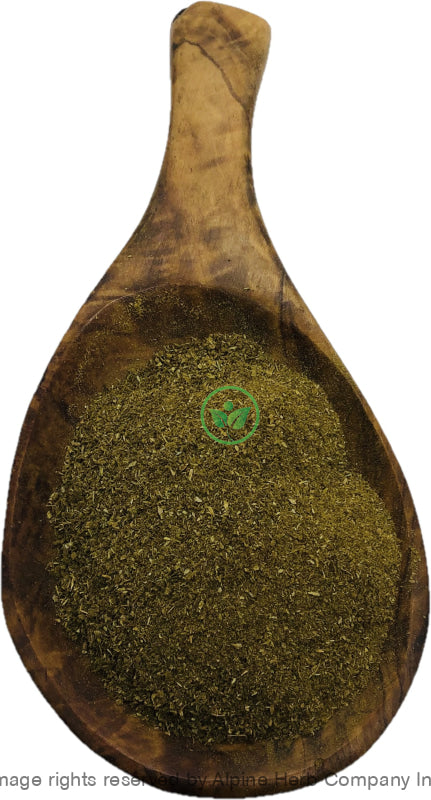Olive Leaves Powder Alpine Herb Company Inc.
$ 8,49 $ 5,09
Botanical Name: Olea europaea
Common Name:
- English: Olive
- Unani: Zaitoon
- Also, known as: Olbaum, African olive, Olivier, European olive, Olivo, Zaytun, Gan lan shu, Zaytoon, Olibh, Gaam laam syuh, Olijf, Elia, Elaia, Elais, Zaitun, Jaitun, Jalapai, Olíva, Olajfa, Olajbogyó, Oliva, Oribu, Aliv, Julipe, Ollibu, Oleevu, Oli, and Saidun
Origin: Spain
Harvested: Cultivated
Parts Used: Leaves
General Information:
Olea europcea, commonly called common olive, is a small, evergreen tree, averaging 20-30 feet or more in height with a rounded crown. One of the world’s oldest cultivated plants, the olive has shaped both the culture and the landscape of the Mediterranean for thousands of years. Young trees have smooth gray bark, but trunks and branches are rough, somewhat picturesquely with age. It has many thin branches with opposite branchlets and shortly-stalked. The leaves are borne in opposite pairs. The leaves are evergreen, opposite, lanceolate leaves about 3-10 cm long and 0.3 to 3 cm wide, acute, elliptic, entire and smooth. The upper surface of the leaf is usually grey-green, while the lower surface is silvery to yellowish-green. Each leaf typically grows over a period of two years before being shed. The flowers of the olive grow in clusters at the base of the leaves, where the leaf meets the stem of the plant. Each cluster, or inflorescence, typically contains between 15 and 30 tiny, fragrant, white to yellowish-white flowers. The flowers of the olive usually form in spring, and are pollinated by insects. Two types of flowers may be present: hermaphroditic flowers, containing both male and female reproductive parts, and unisexual flowers, containing only male reproductive part. The petals of the olive flower are fused, forming a short tube with four lobes. The well-known fruit of the olive is a fleshy drupe containing a hard stone that encloses the seed and contains a single seed. The olive fruit is purple-black when ripe and measures between 0.5 and 4 centimeters in length.
Olives from this species are commercially harvested as eating olives and for production of olive oils. The olive is also planted as an ornamental tree, as well as to control soil erosion and to form firebreaks. An olive branch is a symbol of peace. Many different commercial varieties are grown for fruit production. Olives are not used as a natural fruit because of their extremely bitter taste but are rather consumed either as olive oil or table olives. All parts of the olive tree have been widely used by humans, and this species is said to be the Mediterranean region’s most valuable and versatile crop.
Spain is the largest producer of olives followed by Italy and Greece. These three countries are producing 60% of the world’s total olive production.
How to use:
Powdered Herb:
There are different ways to use powdered herb.
Food Preparation: You can add powdered herbs to any super food, herbal smoothie, sauces, spreads and even cookies. Also for children, you can mix powdered herbs with honey or glycerin to make a paste. The thicker the paste, the more potent and herbal in taste. The sweet taste of honey and glycerin will help the medicine go down. This method is also known as “Electuaries”.
Capsules: Encapsulating your own powdered herb at home, give you assurance that the contents of the capsules are pure herb and no filler or any other products. These capsules can be taken with liquid.
Poultice: Poultice can be made with an herbal powder and liquid (mostly water) to form a paste which is then applied to the skin. This method is very helpful for skin conditions.
Herbal shot: Powdered herb can be mixed with water, fruit juice or other liquid to make herbal shot.
Precautions:
You should consult with a qualified healthcare practitioner before using any herbal products, particularly if you are pregnant, nursing, or on any medications.
All information on this website is for educational purposes ONLY.
This information has not been evaluated by Health Canada.
This information is not intended to diagnose, treat, cure, or prevent any disease.
| Unit Size | 100g, 200g, 400g, 1kg |
|---|
Prompt shipping and expert packing
Thanks to our longstanding association with UPS FedEx DHL as well as other leading global carriers, we can offer a variety shipping options. Our warehouse staff is highly trained and will be able to pack your goods in accordance with our precise and exact specifications. Your items will go through an exhaustive examination before they will be securely packaged before being delivered. We ship to hundreds of thousands of customers daily in different countries. This is a sign of our determination to become the largest online retailer worldwide. Warehouses and distribution centers are located throughout Europe as well as in the USA.
Note that orders containing multiple items are processed according to the particular item.
We will thoroughly inspect all items ordered before shipping. Most orders are shipped within 48 hours. The delivery time will be between 3 and 7 working days.
Returns
The stock market is always changing. It's not entirely managed by us since we're involved with several entities, including the factory and the storage. Therefore, the actual inventory could fluctuate at any moment. Please be aware that it is possible that your order could be out of stock after you've placed your order.
Our policy lasts for 30 days. If it's been more than 30 days since the date you purchased your item We're sorry to say that we can't offer you a full exchange or refund.
You can only return a product if it is unused and still in the same state as when you received it. The item should be in the original packaging.
Related products
Herb Powder
Herb Powder
Herb Powder
Herb Powder
Herb Powder
Herb Powder
Herb Powder
Herb Powder
Herb Powder
Herb Powder
Herb Powder
Herb Powder
Herb Powder
Herb Powder
Herb Powder
Herb Powder
Herb Powder


































